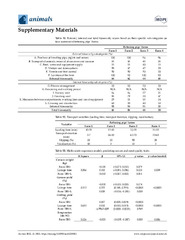| dc.creator | Nastasijević, Ivan | |
| dc.creator | Glišić, Milica | |
| dc.creator | Milijašević, Milan | |
| dc.creator | Janković, Saša | |
| dc.creator | Mitrović, Radmila | |
| dc.creator | Babić Milijasević, Jelena | |
| dc.creator | Bošković Cabrol, Marija | |
| dc.date.accessioned | 2023-03-01T13:52:53Z | |
| dc.date.available | 2023-03-01T13:52:53Z | |
| dc.date.issued | 2022 | |
| dc.identifier.issn | 2076-2615 | |
| dc.identifier.uri | https://vet-erinar.vet.bg.ac.rs/handle/123456789/2584 | |
| dc.description.abstract | The modern pig production chain is increasingly focused on biosecurity, quality, and safety of meat and is associated with many challenges impacting world meat markets, such as animal disease outbreaks and sanitary restrictions, trade regulations and quality requirements. To overcome such challenges and assure more consistent pork meat quality (and safety), there is a need to develop an effective and reliable monitoring system in a farm–abattoir continuum that can be based on selected biomarkers. This study assessed interrelations of selected stress and inflammation biomarkers (acute phase proteins (APP)) between farm biosecurity score versus pork meat quality traits after two different lairage periods. Briefly, the maximum recorded levels of stress hormones (436.2 and 241.2 ng/mL, for cortisol and Chromogranin A (CgA), respectively) and APP (389.4 and 400.9 μg/mL, Pig Major Acute Proteins (MAP) and Haptoglobin (Hp), respectively) at four commercial farms were within the recommended threshold values. Cortisol and APP were negatively correlated to the internal and total biosecurity scores of farms. The increase of level of both sets of biomarkers was found at bleeding (after transportation and lairage period), but with lower values after long (18–20 h) versus short (1–3 h) lairage lay-over time. In general, negative correlation was confirmed between stress and inflammation biomarkers and carcass/meat quality traits. The farm total biosecurity level significantly affected chilling yield, meat temperature, and a* value. Pig-MAP emerged as a good biomarker with a promising potential for assessment and anticipation of broad aspects in the pork meat chain. It can be used for detection of failures in the pig production system and might be incorporated in certification programs for the pork meat industry. | |
| dc.language | en | |
| dc.publisher | MDPI | |
| dc.relation | info:eu-repo/grantAgreement/MESTD/inst-2020/200050/RS// | |
| dc.relation | info:eu-repo/grantAgreement/MESTD/inst-2020/200143/RS// | |
| dc.relation.isreferencedby | https://doi.org/10.3390/ani12233382 | |
| dc.relation.isreferencedby | https://vet-erinar.vet.bg.ac.rs/handle/123456789/2544 | |
| dc.rights | openAccess | |
| dc.rights.uri | https://creativecommons.org/licenses/by/4.0/ | |
| dc.source | Animals | |
| dc.subject | acute phase proteins | |
| dc.subject | biomarkers | |
| dc.subject | biosecurity | |
| dc.subject | farm | |
| dc.subject | meat quality | |
| dc.subject | pig chain | |
| dc.subject | stress hormones | |
| dc.title | Supplementary information for the article: Nastasijević, I., Glišić, M., Milijašević, M., Janković, S., Mitrović, R., Babić Milijasević, J.,& Bošković Cabrol, M.. (2022). Biosecurity and Lairage Time versus Pork Meat Quality Traits in a Farm–Abattoir Continuum. in Animals MDPI., 12(23), 3382. https://doi.org/10.3390/ani12233382 | |
| dc.type | dataset | en |
| dc.rights.license | BY | |
| dc.citation.volume | 12 | |
| dc.citation.issue | 23 | |
| dc.description.other | Supplementary material for: [https://doi.org/10.3390/ani12233382] | |
| dc.description.other | Related to published version: [https://vet-erinar.vet.bg.ac.rs/handle/123456789/2544] | |
| dc.identifier.fulltext | http://veterinar.vet.bg.ac.rs/bitstream/id/7466/Biosecurity_and_Lairage_sup_2022.pdf | |
| dc.identifier.rcub | https://hdl.handle.net/21.15107/rcub_veterinar_2584 | |
| dc.type.version | publishedVersion | |

